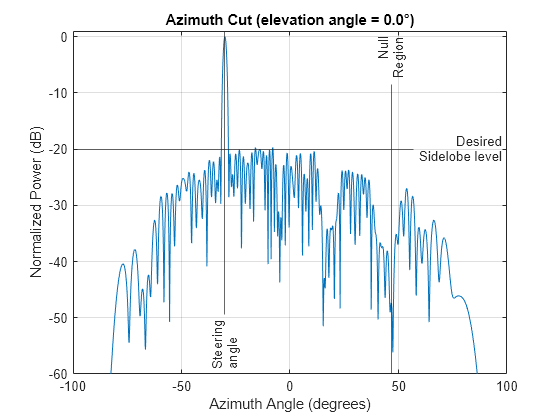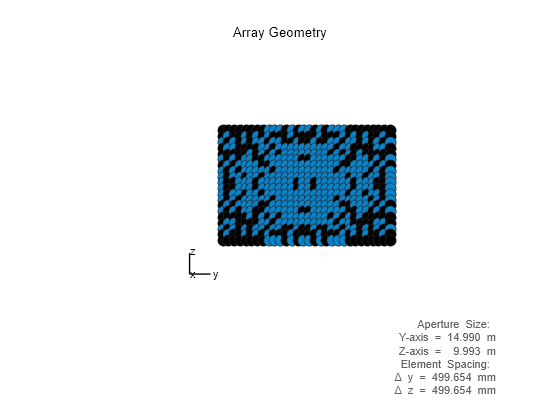thinnedArray
Syntax
Description
thinarray = thinnedArray(array,freq,steerang,sll)thinarray with a reduced number of elements created by thinning an
array. A thinned array is a copy of an array
with the Taper property set to the product of the
Taper values of array and the derived thinning
coefficients. Thinning coefficients are either 0 or 1.
Zeros indicate that the corresponding array elements are 'off' (inactive)
and ones indicate that the corresponding array elements are 'on'
(active). This object function applies only to the phased.ULA or phased.URA System objects. The
freq argument is the array operating frequency,
steerang is the array steering direction, and
sll is the desire sidelobe level. This object function uses an
optimization procedure to find a thinned set of array tapers for the original
array such that the resulting array pattern evaluated at the
frequency freq, for the steering direction
steerang, has a sidelobe level equal to or below
sll.
You must have a Global Optimization Toolbox license to use this object function.
thinarray = thinnedArray(___,Name = Value)thinarray with thinning coefficients computed
so that the specified parameter Name is set to the specified
Value. You can specify additional name-value pair arguments in any
order as (Name1 = Value1, ...,
NameN = ValueN).
Examples
Input Arguments
Name-Value Arguments
Output Arguments
Algorithms
This object function utilizes a global optimization procedure based on the genetic
algorithm to compute the array thinning coefficients. The global optimization does not
guarantee that the found solution is the optimal solution. It also does not guarantee
satisfaction of the sidelobe level and the null region constraints. The maximum sidelobe level
and the minimum null region depth reported in the returned info
struct are the values computed during the optimization by evaluating the
array pattern over an angular grid. The actual values can be higher if the array pattern is to
be evaluated over a finer angular grid. Additionally, due to the nature of the genetic
algorithm the same set of input values will produce different results at each run. To ensure
the reproducibility of the results from run to run, fix the random number generator seed using
the rng function before calling
thinnedArray.
References
[1] Rocca, Paolo, Giacomo Oliveri, Robert J. Mailloux, and Andrea Massa. "Unconventional phased array architectures and design methodologies - a review". Proceedings of the IEEE 104, no. 3 (2016): 544-560.
[2] Haupt, Randy L. "Thinned arrays using genetic algorithms". IEEE transactions on antennas and propagation 42, no. 7 (1994): 993-999.
Version History
Introduced in R2023b


